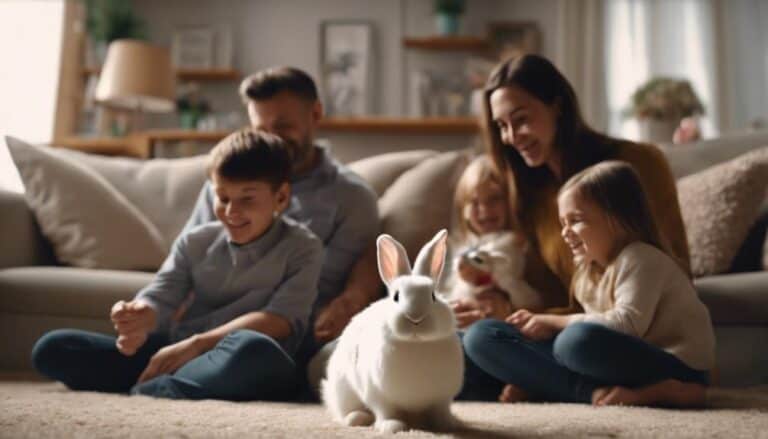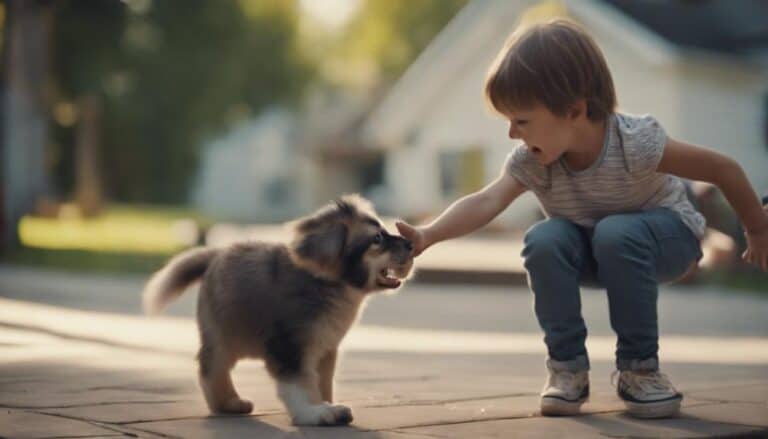Ever stopped to think about how many pet rabbits get abandoned every year?
The numbers are pretty surprising, and they highlight a worrying trend that needs some attention.
When you look at the stats and the reasons behind this issue, you start to understand the challenges these furry friends face.
Let's take a closer look at the impact of rabbit abandonment and why it's so important to be a responsible pet owner to ensure these vulnerable animals are okay.
Contents
- 1 Key Takeaways
- 2 The Impact of Rabbit Abandonment
- 3 Statistics on Abandoned Pet Rabbits
- 4 Reasons Behind Rabbit Surrender
- 5 Consequences of Housing Issues
- 6 Unplanned Litters and Abandonment
- 7 Health Problems and Owner Surrender
- 8 Rescue Centers' Capacity Challenges
- 9 Importance of Rabbit Welfare Education
- 10 Commitment Needed for Rabbit Care
- 11 Conclusion
Key Takeaways
So, you're wondering how many pet rabbits are abandoned? Unfortunately, the numbers are going up. In 2018, about 10,000 pet rabbits were abandoned. By 2019, that number had increased to 12,500. The following year, in 2020, it rose even more to 14,200.
In 2021, things didn't get better – 16,000 pet rabbits were left behind. And sadly, the trend continued in 2022, with 18,700 abandoned pet rabbits. The statistics clearly show that more and more rabbits are being abandoned every year.
The Impact of Rabbit Abandonment
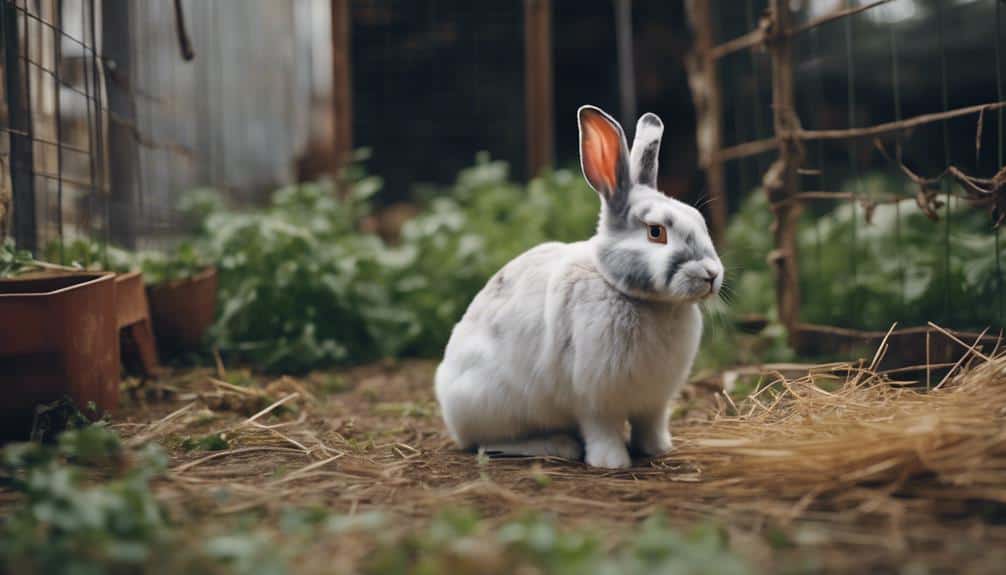
Ditching pet rabbits is a huge problem. It's not just that it's cruel to the animals – it also adds to the already overwhelming number of rabbits in shelters.
When people abandon their pet rabbits, the rabbits are left to fend for themselves. This means they don't get enough food, have to deal with extreme temperatures, and are easy prey for predators. It's a slow and painful way for these innocent creatures to die.
Rabbit rescue organizations are doing vital work to help these abandoned rabbits. They're dedicated groups that rescue, care for, and find new homes for these animals.
This gives the rabbits a second chance at a happy life.
Statistics on Abandoned Pet Rabbits
The number of pet rabbits being abandoned each year is a pretty alarming statistic. It highlights the need for more awareness and responsible pet ownership. To drive positive change, we need to understand the scale of this issue.
Rescue groups do some amazing work by providing care and finding new homes for these unwanted rabbits. Unfortunately, the numbers show that many pet rabbits are left without homes each year.
| Year | Number of Abandoned Rabbits |
|---|---|
| 2018 | 10,000 |
| 2019 | 12,500 |
| 2020 | 14,200 |
| 2021 | 16,000 |
| 2022 | 18,700 |
We can work together to reduce the number of abandoned rabbits and find them loving families by supporting rescue groups and promoting responsible pet ownership.
Reasons Behind Rabbit Surrender
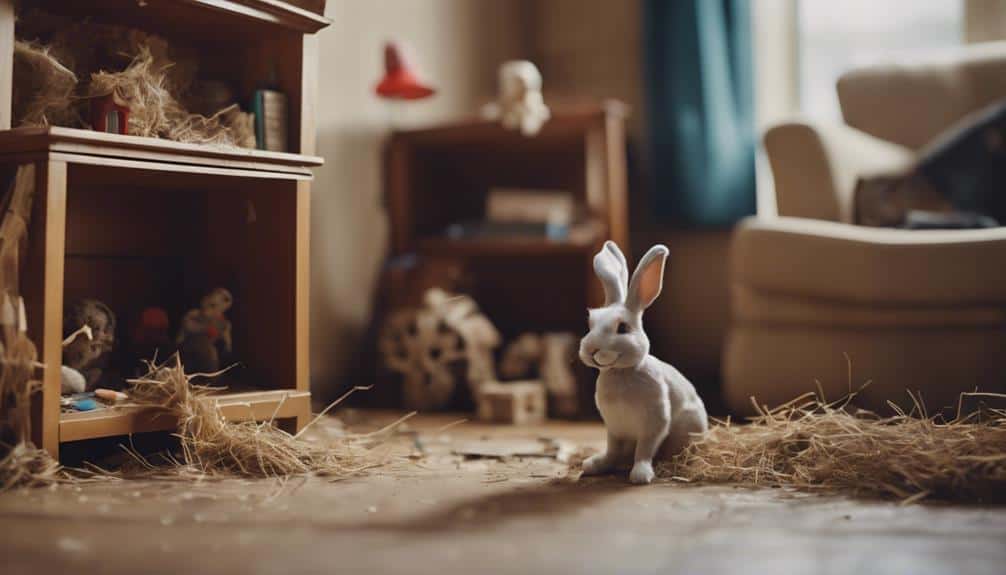
Many pet owners surrender their rabbits due to unforeseen circumstances or challenges they face. Owning a rabbit is a big responsibility that requires time, effort, and resources.
One common reason behind rabbit abandonment is that people don't know enough about taking care of them. Rabbits need a specific diet, a proper place to live, and social interaction. Some owners mightn't be prepared for these needs, which can lead to them giving up their rabbits.
Financial problems can also cause owners to abandon their rabbits. When people can't afford to take their rabbits to the vet or buy the supplies they need, they might feel like they've no choice but to give them up.
Behavioral issues can also contribute to rabbit surrender. If a rabbit is aggressive, destructive, or has trouble using its litter box, some owners might feel overwhelmed and decide to abandon their pet.
Sometimes, changes in living situations can also force owners to give up their rabbits. For example, if someone moves to a place where pets aren't allowed, they might've to surrender their rabbit.
It's essential for people who want to own a rabbit to learn about their needs before bringing one home. This can help prevent situations where rabbits are abandoned due to challenges that could have been avoided.
Consequences of Housing Issues
Rabbits that don't have a good place to live are at risk of getting very sick or hurt.
If we don't take care of their living conditions, they can get illnesses and injuries that could have been prevented.
This isn't only bad for the rabbits, but it also puts a lot of pressure on animal shelters and rescue organizations.
They already have a hard time taking care of all the animals that need help, and the extra abandoned rabbits just make things worse.
Health Risks of Neglect
Neglecting the housing needs of pet rabbits can lead to serious health risks for these vulnerable animals. Rabbits require specific living conditions to thrive, and when those requirements aren't met, it can have detrimental effects on their well-being.
One major issue is poor ventilation. When there's not enough airflow, it can cause respiratory problems in rabbits. They need fresh air to breathe, just like we do! Without it, they can develop serious health issues.
A dirty living environment is another significant problem. When waste accumulates, it creates the perfect breeding ground for bacteria and germs. This can lead to skin infections, which can be painful and even life-threatening for rabbits.
Rabbits also need a proper diet that includes all the essential nutrients they require. Without these nutrients, they can develop digestive issues that can cause a range of problems, from diarrhea to malnutrition.
Exercise is crucial for rabbits, too. They need space to move around and stretch their legs. When they're confined to a small area, they can develop muscle weakness, which can affect their overall health.
Lastly, overcrowding is a major issue. When there are too many rabbits in a small space, it can lead to aggression between them. This can cause stress, injuries, and even fatalities.
Impact on Shelters
When people don't understand how to care for pet rabbits, it leads to big problems for shelters. Rabbits are constantly being surrendered or abandoned by their owners, and shelters are left to deal with the consequences. These rabbits often arrive at shelters malnourished, neglected, or sick.
This is especially true after holidays like Easter, when many people buy rabbits on impulse without thinking about the long-term care they require.
Lots of people get rabbits without realizing how much work they are. Rabbits aren't low-maintenance pets, and they need special care, including a specific diet and living environment. When owners can't provide this care, they often give up and surrender their rabbits to shelters.
This not only puts a strain on shelters but also means that many rabbits don't get the care they need.
The high cost of veterinary care for rabbits is another issue. Many people don't realize how expensive it can be to care for a rabbit, and this can lead to owners abandoning their pets when they can't afford their care.
To fix this problem, we need to educate people about responsible rabbit ownership. We need to spread the word about how to properly care for rabbits, including their dietary, housing, and healthcare needs.
By doing this, we can reduce the number of rabbits being surrendered to shelters and ensure that they get the care they deserve.
If you want to help, consider supporting your local shelters or adopting a rabbit yourself.
This can make a big difference in the lives of these amazing animals.
Unplanned Litters and Abandonment
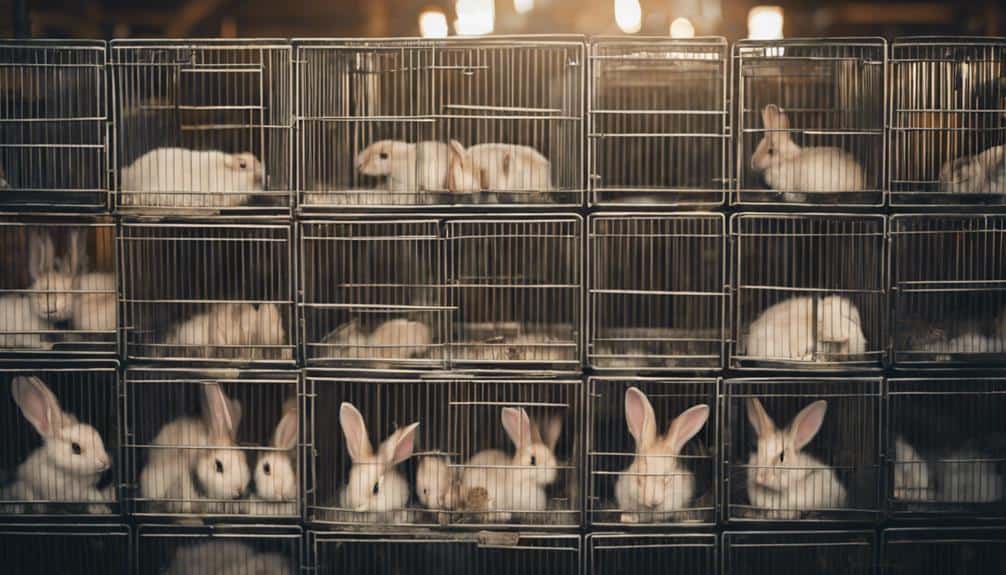
Abandonment is a huge problem for rabbits, and it's often a result of people not being responsible pet owners. When people breed rabbits without knowing what they're doing or without being in control, it can lead to unwanted pregnancies and eventually, abandonment.
This adds to the already huge number of rabbits in shelters, which puts a lot of pressure on resources and makes it more likely that these abandoned rabbits will be put down.
Imagine you have a rabbit and it has babies unexpectedly. Suddenly, you have a lot more pets to take care of than you planned for. Without a plan for what to do with the babies, some people just abandon them, thinking it's the easiest solution.
But this is really bad for the rabbits that are left behind. They've to fend for themselves without proper care and shelter, which is a really tough situation for them.
So, how can we stop this cycle of abandonment? The most important thing is for pet owners to spay or neuter their rabbits and to breed them responsibly.
If people knew more about the bad things that can happen when rabbits are bred without control, we could reduce the number of rabbits that are abandoned and have to suffer.
Health Problems and Owner Surrender
When health problems arise in rabbits, owners often face tough decisions that may lead to surrendering their pets to shelters. Rabbit health issues can be complex and require specialized care and attention. If owners can't provide the necessary medical treatment or accommodations, they might feel forced to give up their beloved pets.
It's crucial for owners to know about common health problems in rabbits and seek veterinary help quickly to ensure their pets' well-being. Some common health issues in rabbits that might lead to owner surrender are listed in the table below:
| Health Problem | Description | Treatment |
|---|---|---|
| Dental Issues | Overgrown teeth cause pain and malocclusion | Regular dental trims |
| Gastrointestinal Stasis | Digestive system slowdown leading to bloating | Medication and diet changes |
| Respiratory Infections | Commonly caused by bacteria or viruses | Antibiotics and supportive care |
| Pododermatitis | Sore hocks due to pressure or unsanitary conditions | Clean bedding and wound care |
| E. cuniculi Infection | Parasitic infection affecting the nervous system | Antiparasitic medication |
Knowing about these health problems and taking proactive steps can prevent the heartbreaking decision of surrendering a rabbit due to health issues. By being proactive, owners can protect their rabbits from these problems and give them a comfortable, healthy life.
Rescue Centers' Capacity Challenges
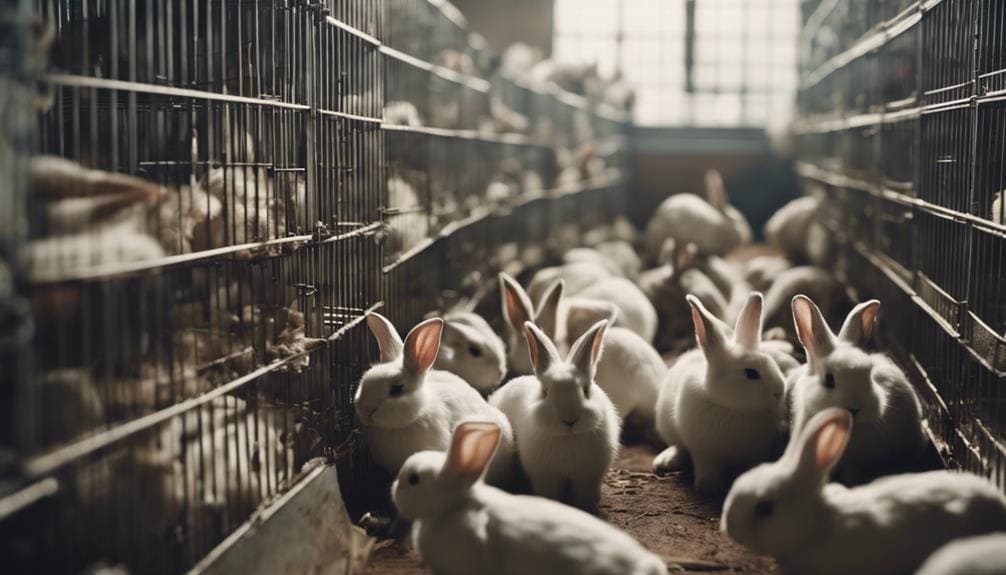
Rescue centers face a tough challenge when it comes to managing the number of abandoned pet rabbits they can take in. The truth is, there are just too many domestic rabbits being abandoned, and it puts a huge strain on the resources of these centers.
So, how can they cope with this limited capacity? One solution is to set up foster care programs. This means getting members of the local community to temporarily take in rabbits until a permanent home is found. By doing this, rescue centers can free up some much-needed space for other rabbits in need.
Another approach is for rescue centers to team up with other animal welfare organizations. By working together, they can share resources and move rabbits to facilities that have more space available. This way, no rabbit is left without care.
Promoting adoption events is also a great way to tackle the capacity issue. By hosting events or partnering with pet stores, rescue centers can showcase the rabbits that need a new home. This helps to find loving families for the rabbits already in their care, which in turn frees up space for new arrivals.
Importance of Rabbit Welfare Education
Understanding the importance of rabbit welfare education is crucial for safeguarding the well-being of these vulnerable animals in our care. When people don't know how to properly care for rabbits, it can lead to situations where they're abandoned due to neglect or misunderstanding.
By learning about their needs, behaviors, and proper care, individuals can provide a loving and suitable environment for their pet rabbits.
Rabbit welfare education provides knowledge on proper diet, which guarantees rabbits are healthy and happy. It teaches about appropriate housing, which prevents stress and behavioral issues. Education on veterinary care fosters long and fulfilling rabbit-human relationships.
Moreover, it raises awareness on socialization needs, reducing the chances of abandonment. Emphasizing the importance of spaying/neutering helps control rabbit overpopulation.
Commitment Needed for Rabbit Care
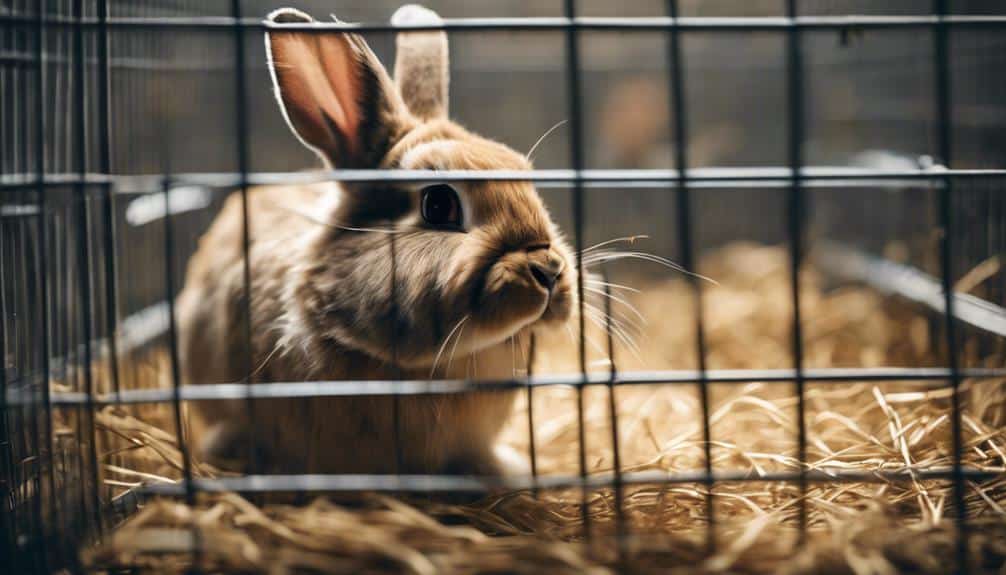
So you want to make sure your pet rabbit is happy and healthy? That's great! To do that, you need to understand the basics of rabbit care and be prepared to make a commitment.
First, you'll need to provide a suitable living environment for your rabbit. That means a spacious cage or enclosure that's safe, comfortable, and clean. You'll also need to make sure your rabbit has access to hiding places, toys, and opportunities for exercise.
Next, you'll need to feed your rabbit a balanced diet. Rabbits are herbivores, so they need a lot of fiber and limited amounts of protein and fat. You can buy rabbit pellets and hay at a pet store, and supplement with fresh veggies and fruits.
Regular veterinary check-ups are also crucial. Rabbits are prone to certain health issues, such as dental problems and respiratory infections, so you'll need to work with a vet to catch any problems early.
Rabbit Care Basics
So you're thinking of getting a pet rabbit? That's a big responsibility, but with the right care, your furry friend can live a happy and healthy life.
First, let's talk about food. Your rabbit's diet should include unlimited timothy hay, lots of leafy greens, and limited pellets. It's crucial to understand what your rabbit needs to eat to stay healthy and avoid dietary problems.
Rabbits need regular grooming, exercise, and check-ups with the vet to stay healthy. Make sure you budget for these expenses and plan for routine care – it's essential for your pet's overall well-being.
Your rabbit should live indoors at all times to stay safe. You'll need to provide a suitable enclosure that meets their spatial and social needs, so they've a comfortable and secure place to call their own.
Preventing Rabbit Abandonment
So, you're wondering how to ensure you're committed to caring for your rabbit and preventing abandonment.
It's a big responsibility, but with the right approach, you can provide a happy and healthy life for your furry friend.
Rabbits need proper care and attention to thrive. That means understanding what's required to meet their needs.
To prevent abandonment and promote animal welfare, let's break it down into simple, actionable tips.
If you want to provide a safe and comfortable environment for your rabbit, you'll need to provide proper shelter and protection outside.
This safeguards them against predators and harsh weather. A balanced diet with a variety of fresh vegetables and hay is also essential, as it fosters good health and prevents nutritional deficiencies.
Rabbits need exercise and social interaction to stay happy and healthy.
Allocate time for daily activities that stimulate their mental and physical well-being. Regular veterinary check-ups and vaccinations are also crucial, as they facilitate early detection of health issues and prevent diseases.
Finally, spaying or neutering your rabbit can reduce aggressive behavior and prevent unwanted litters.
Conclusion
It’s heartbreaking to think about the huge number of pet rabbits that get abandoned. These aren’t just statistics – they’re living creatures that deserve love and care. Many people underestimate the commitment required to care for a rabbit, leading to a tragic cycle of neglect. It’s essential to educate potential pet owners about the responsibilities that come with rabbit care, as the question often arises, “are rabbits good pets? ” When given proper attention, they can be affectionate companions, bringing joy and warmth to any household.
Each abandoned rabbit has a story of neglect and heartbreak behind it. We need to speak up for these innocent animals and promote responsible pet ownership. People need to understand how to properly care for rabbits.
If we work together, we can change things and make sure every rabbit finds a loving home to call their own.



